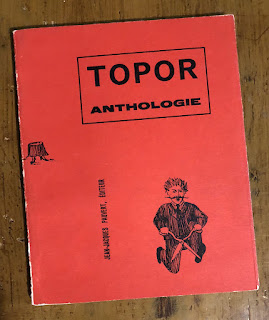I'm not, frankly, a fan. I DO get the concept. I know why other people find these collectable. I'm just not one of those people.
These three are publications from the same source and roughly the same year (Clementine was later, I believe). Jean-Jacques Pauvert is most notable for publishing the works of the Marquis de Sade in the 1950s, for which he is sued for "contempt of good manners" and defended by a famous lawyer, Master Maurice Garçon. He also published other works, including the first publications of noteworthy authors.
These little books are essentially chapbooks. They were called Libertés, pocket-sized and black and white using kraft paper they were able to bring original work to people at a much reduced manufacturing cost.
Clementine Cherie
 |
| Cover of Clementine Cherie by Jean Bellus |
Jean Bellus Was a French illustrator who died in 1967. He was fairly well known, and his most famous character was Clementine Cherie.
Clementine Cherie is a sexy, cheeky girl who is most often in a state of undress. She's uninhibited and apparently all about "l'amour."
This book is full of cartoons that depict Clementine Cherie in different scenarios, but it was very hard to find her in one that did not involve either nudity or the depiction of sex (or shortly before/after sex).
 |
| And I do not even know why I told you that I'm a painter, I ... I have a good hardware business. |
Les 32 Positions de l'Androgyne
Maurice Henry was a cartoonist, sculptor, painter, playwright and member of the Surrealist art movement. He was also involved in cinema. He's rather noteworthy as an artist.
I can't really show much of the inside of this book. All the illustrations are pretty sketchy. The premise is conjoined twins—one of each sex—and how complicated their lives can be, most especially their sex lives, and that gets even more complicated when they become involved with other conjoined twins.
Despite my censorship of it, this book does have monetary value. It's not the priciest of the three, but it's pretty good.
Topor Anthologie
 Roland Topor was a French illustrator and cartoonist (and painter and playwright, film and television writer and actor) who was born in Poland in 1938 and had been hidden from the Nazis. He wrote the novel "The Tenant" which was later made into a movie by Roman Polanski.
Roland Topor was a French illustrator and cartoonist (and painter and playwright, film and television writer and actor) who was born in Poland in 1938 and had been hidden from the Nazis. He wrote the novel "The Tenant" which was later made into a movie by Roman Polanski.He was also a Surrealist and that shows up very clearly in this little book. Even on the cover, which shows on the front a man with pruning shears and what looks to be a stump. You can see when the cover carries over to the back, that it was the bottom of a woman, and now she is cut down, as is a man, a tree, a house…you see where this goes.

This is a book full of absurd cartoons. They're all interesting, some of them make no sense to me at all, but they are intriguing.
Again, there were some cartoons I didn't think were good to show here. Mostly, this is about the sensibilities of a different era, I suppose.
































